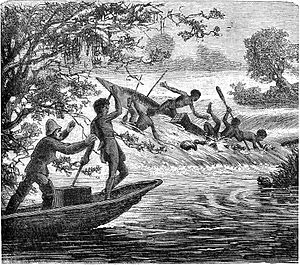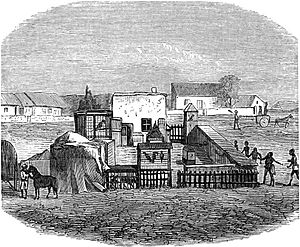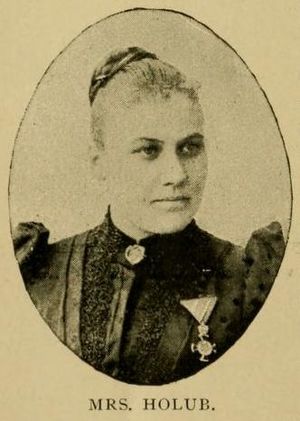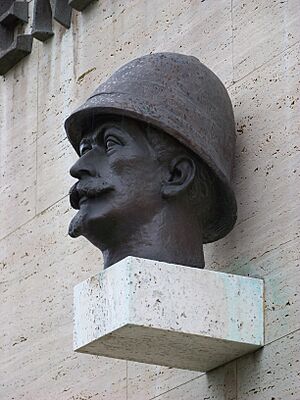Emil Holub facts for kids
Quick facts for kids
Emil Holub
|
|
|---|---|
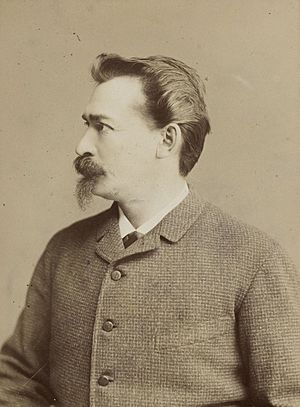 |
|
| Born | 7 October 1847 Holice, Kingdom of Bohemia
|
| Died | 21 February 1902 (aged 54) |
| Nationality | Czech |
| Alma mater | Prague University |
| Scientific career | |
| Fields | Ethnography, exploration |
Emil Holub (born October 7, 1847 – died February 21, 1902) was a famous Czech doctor, explorer, mapmaker, and expert on different cultures in Africa. He spent many years exploring parts of southern Africa, collecting amazing items, and drawing detailed maps.
Contents
Early Life and Education
Emil Holub was born in Holice, a town in eastern Bohemia. This area is now part of the Czech Republic. His father was a local doctor.
Emil went to a German-language grammar school in Žatec. Later, he studied at Prague University. In 1872, he earned his degree as a doctor of medicine.
Adventures in Africa
Emil Holub was inspired by the travel diaries of another famous explorer, David Livingstone. After finishing his studies, Holub traveled to Cape Town, South Africa. He soon settled in Dutoitspan, near Kimberley, to work as a doctor.
After about eight months, Holub joined a group of local hunters. He went on a two-month "scientific safari." This was his first trip to collect items for a large natural history collection.
First Expeditions
In 1873, Holub went on his second scientific safari. This time, he focused on collecting items that showed how different cultures lived. These items are called ethnographic material.
On his third trip in 1875, he traveled all the way to the Zambezi River. He created the first detailed map of the area around Victoria Falls. Holub also wrote the first book in English about Victoria Falls. It was published in 1879.
A Grand Plan and Challenges
After returning to Prague for a few years, Holub planned a very bold expedition. In 1883, he set out with his wife, Rosa (who was 18 years old), and six European guides. Their goal was to explore the entire length of Africa, from Cape Town to Egypt.
However, this long journey faced many problems. The team suffered from illnesses like malaria. They also had trouble with some local tribes, like the Ila people. Because of these difficulties, Holub's team had to turn back in 1886. They could not complete their amazing journey across Africa.
Later Life and Legacy
After his expeditions, Holub organized two exhibitions to show his collections. One was in Vienna in 1891, and another in Prague in 1892. Many people came to see them, but Holub lost money on these shows.
He was sad that he could not find a permanent home for his huge collection of artifacts. So, he slowly sold or gave away parts of it to museums, science centers, and schools.
Emil Holub continued to write articles and give lectures about his travels. He passed away in Vienna on February 21, 1902. His death was caused by ongoing health problems, including malaria, that he got during his time in Africa.
Remembering Emil Holub
Emil Holub's adventures and scientific work are still remembered today.
- In 1949, a monument to Holub was built in his hometown of Holice.
- In 1952, a Czech movie called Velké dobrodružství (Great Adventure) was made about his expeditions.
- In 1970, Holice opened a museum dedicated to Emil Holub. A nearby school, the gymnasium, was named after him in 1999.
- On February 20, 2002, the Czech National Bank released a special silver coin. It was worth 200 CZK and honored 100 years since Holub's death.
- From 2002 to 2006, the Czech Embassy in Harare held events to remember Emil Holub.
- In a 2005 poll, he was voted #90 among the 100 greatest Czechs.
- In September 2005, a statue of Holub was unveiled in Livingstone, near Victoria Falls. This was exactly 130 years after his first visit there.
See also
 In Spanish: Emil Holub para niños
In Spanish: Emil Holub para niños


